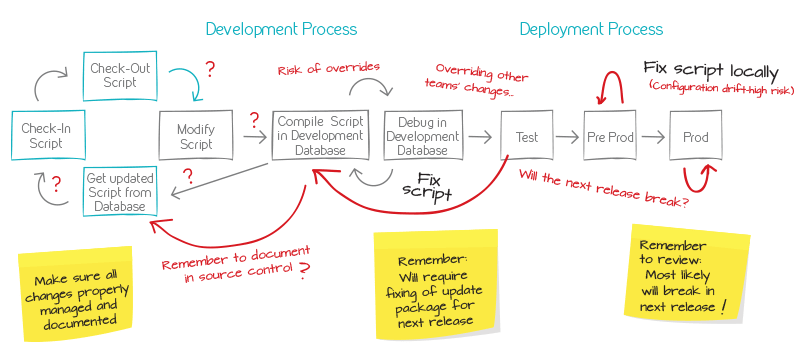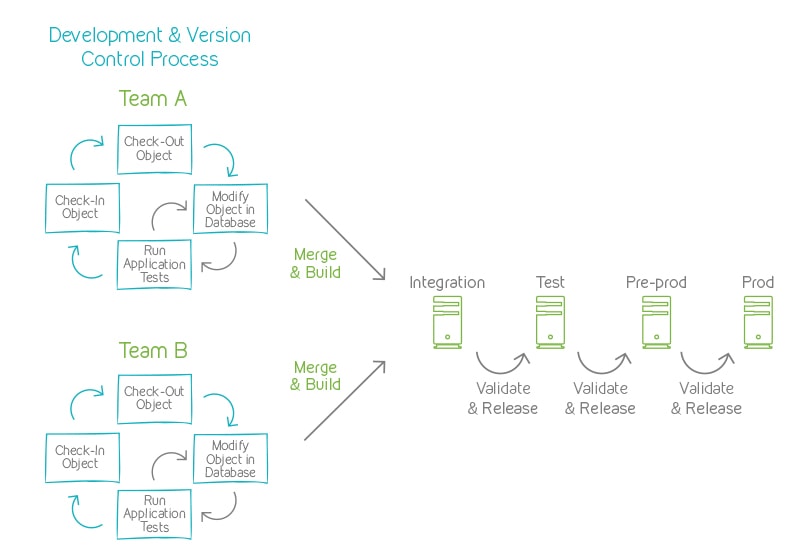Database development requires agile methodologies and continuous principles to keep up with frequent application updates. To address the unique challenges of database development, DBAs and developers must implement effective lifecycle solutions. This article explores four essential database development lifecycle solutions that can significantly improve efficiency, reduce errors, and protect valuable data.
Database Release Automation
What Is Database Release Automation?
Database release automation is the process of automatically deploying database changes across different environments, from development to production. This solution streamlines the deployment process, reducing manual intervention and potential errors.
How Release Automation Eliminates Errors in Deployment
Release automation provides a safety net by eliminating the possibility of overriding critical changes in the target environment. It automatically generates deployment scripts, saving hours of valuable development time and avoiding human errors that can lead to devastating crashes and cost your company thousands – even hundreds of thousands – of dollars to rectify.
Pro Tip 1: Start small when implementing database release automation by focusing on one critical workflow. Gradually expand automation across your database lifecycle to ensure a seamless transition.
Database Merge and Build Automation
Why Database Merge and Build Automation Is Critical for CI/CD
Merge and build automation bridges the gap between application code and database development, enabling true continuous integration and delivery for databases. This solution allows for deploying database changes in accordance with business requirements and utilizing impact analysis with three-way, baseline-aware analysis.
Overcoming Manual Bottlenecks in Database Development
By automating the merge and build process, developers can merge database code with unparalleled ease. This automation significantly reduces manual steps in the continuous delivery process, which is crucial considering that only 13% of companies reported being able to fully automate this process for databases.
Database Enforced Source Control
How Source Control Improves Collaboration and Transparency
Database enforced source control provides a single source of truth for your database, enabling teams to work safely and simultaneously within the same environment. This solution eliminates the possibility of overriding critical changes made by another developer, fostering collaboration and transparency.
Best Practices for Implementing Database Source Control
Implement source control that interfaces with leading SCM software packages to enable a complete and safe collaborative development process. This approach mirrors the familiar and proven process used in native/application code development.
Avoiding Development Bottleneks with Source Control
Skipping database enforced source control can result in lengthy development cycles with time-consuming, frustrating manual processes. By implementing this solution, teams can significantly reduce development time and minimize errors.
Database Enhanced Security and Regulatory Compliance
Enhanced security mechanisms are crucial for controlling changes to database objects and enforcing roles and responsibilities. This solution helps prevent unauthorized and undocumented changes to the database, providing the ability to define access levels down to the individual object and data level. A robust security solution should also offer a complete, reliable audit trail while minimizing manual documentation requirements. This ensures smooth development and deployment while providing segregation of duties (SoD).Pro Tip 2: Regularly review and update database access policies to align with evolving compliance requirements and security threats. This helps maintain robust protection for your data.
Emerging Trends in Database Development Lifecycle Solutions
As database development continues to evolve, new trends are emerging in lifecycle solutions. These may include increased integration with cloud platforms, AI-driven optimization of database performance, and enhanced automation across the entire database lifecycle.
Protect The Data
Implementing these four database lifecycle management solutions can significantly reduce costly delays, application glitches, back-outs, and most importantly, database downtime. While it’s possible to adopt a single tool or solution to address a particular pain point, all four solutions are necessary to enable true database deployment automation and protect your company’s valuable data.
Key Takeaways
- Database release automation reduces errors and saves development time.
- Merge and build automation is crucial for implementing CI/CD in database development.
- Enforced source control improves collaboration and reduces development bottlenecks.
- Enhanced security and compliance measures protect against unauthorized changes and ensure regulatory adherence.
- Implementing all four solutions enables true database deployment automation and data protection.
By adopting these database development lifecycle solutions, organizations can streamline their processes, reduce risks, and ensure the efficient management of their critical data assets.








